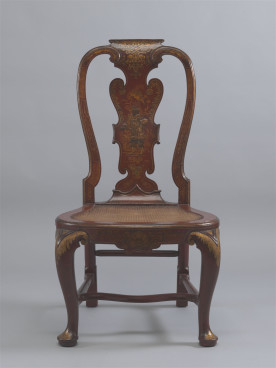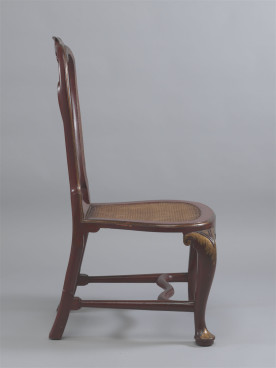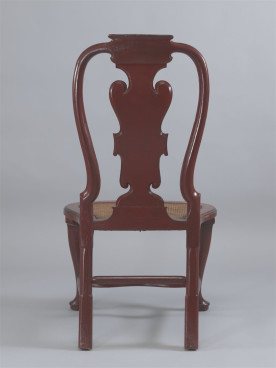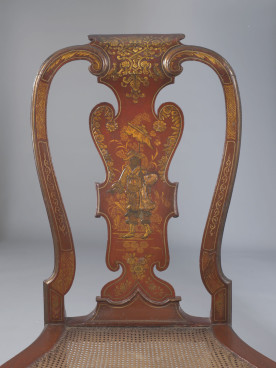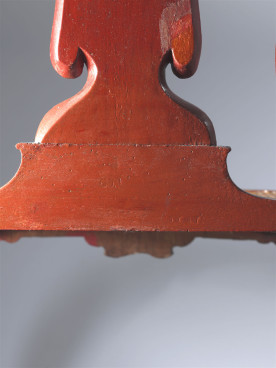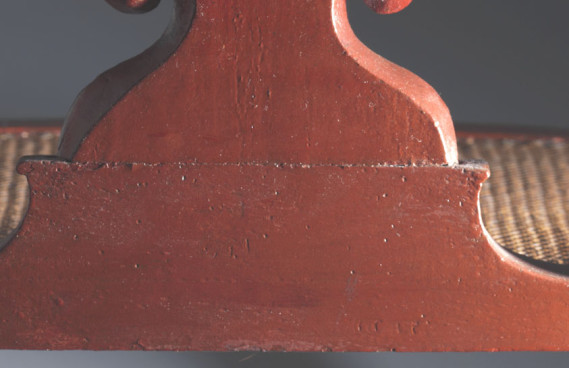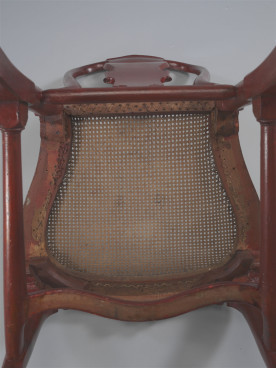Chair, c.1735–45
Beech with red and gold japanned decoration and cane
This Giles Grendey chair is one of a pair from a larger suite of at least seventy-two pieces commissioned by Juan do Dios de silva y Mendoza y Haro, 10th Duke of Infantado (1672–1737), Lazcano Castle, northern Spain. The back of the shoe is stamped ‘IT’.
Adam Bowett Catalogue (19/08/2012)
Description
A pair of red and gold japanned chairs, c.1735. The backs have scrolled and waisted uprights centered on a raised, tableted crest rail, over a baluster splat, the caned, compass seat with a moulded edge and shell-decorated front rail, raised on leaf-decorated cabriole legs with pad feet, joined to the turned back legs by wavy H stretcher.
Dimensions
H: 39 ¾ ” (101cm) Seat height: 16” (41cm) W: 21 ½ ” (55cm) D: 22 ½ “ (57cm)
Designer / Maker:
Giles Grendy (1693-1780).
Materials
Beech and other woods
Dating criteria
This chair is part of a large suite supplied by Giles Grendey to the Duke of Infantado at Lazcano Castle, Spain, all elements of which are stylistically consistent with a date in the mid-1730s.
Construction
Much of the construction is obscured by the japanned decoration. However, the back of the chair appears to be made in the conventional fashion, the posts being thicknessed to add curvature and jointed in the usual way at the usual places. Similarly, the stretcher configuration and its attachment to the front and back legs is entirely conventional. The construction of the seat is determined by the caning, which requires the seat rails to be relatively shallow. The seat frame is in three sections – two curved side pieces and a curved front section. They are probably half-lapped over the tops of the front legs and tenoned into the rear posts. Additional depth and strength is provided by shaped blocks glued to the underside of the rails. The legs are probably tenoned or dovetailed up into the seat frame and reinforced by shaped brackets with further shaped blocks behind now. These are now secured by screws. Below the front of the seat and fitted between the front legs there is a shaped apron which is fixed in place by two screws.
Marks or stamps
20.1 – On the back rail there are a number of stamps faintly evident underneath the japanning – CM (?), IT (twice). The inside of the back rail has a penciled VI
20.2 – There are a number of indentions on the back of the back rail but later overpainting makes it impossible to determine whether these are stamped initials. There is a penciled numeral VI on the inside of the back rail.
Condition
20.1 – There has been extensive re-touching to the japanning but the degree of re-touching can only be determined by a detailed surface analysis. The chair is structurally sound, but there is evidence of repaired breaks to the joint between the left back post and crest rail, and the screws securing elements of the seat frame and the blocking are clearly modern. The blocks supporting the forelegs may be replacements. The caning is clearly not original, and there are extensive glued repairs to the front rail where it has started to disintegrate along the line of the cane holes. There are unexplained screw holes in the undersides of the back, front and side rails, which might suggest that a board was once fixed to the underside of the seat to support collapsed cane.
20.2 – Japanning as for 20.2. There is a batten cut into and added to the back rail, presumably at the time of re-caning. Both blocks supporting the joint between side rails and back posts are replacements, as are the screwed blocks supporting the front legs. Caning is clearly not original. There are unexplained screw holes to the underside of the rails similar to those on 20.1 which strengthen the surmise that a board or other reinforcement was once fixed to support the cane.
Additional remarks
This suite was photographed in Lazcano Castle in the late 19th century; the photo was later published in Cristina de Arteaga, La Casa del Infantado, Vol. II, Madrid (1944). Most of the suite was bought in 1930 by Adolph Loewi and taken to his shop in Venice. Loewi acquired 72 pieces, including fifty chairs, twelve armchairs, two day-beds, two pairs of mirrors, a pair of candlestands, a card table and a tripod table. Two desks-and bookcases remained at the Castle, one of which was later purchased by the Spanish Art Gallery in London. This or its pair was recently (2012) on the market with Michael Hughes Antiques, London.
Of the seat furniture, 24 chairs and 4 armchairs are owned by the Rosen Foundation, New York; the Metropolitan Museum has an armchair; the V&A has a day-bed; the National Gallery of Victoria has a day-bed; Temple Newsam House, Leeds, has six chairs and two armchairs; a number of other privately owned pieces are recorded in Antiques (April & December 1971); two further armchairs were acquired by French & Co., New York in the 1980s. present location unknown.
References
W. Symonds, ‘Giles Grendey and the Export Trade of English Furniture to Spain’, Apollo (December 1935), pp. 336-42
Edwards and M. Jourdain, Georgian Cabinet-Makers, 3rd edn., London (1955), pp. 47-8, pls. 47 & 50.
Connoisseur (June 1964), p. 120.
Leeds Art Calendar, No. 66 (1970), p. 3.
Collector’s Guide (January 1971), p. 68.
Christopher Gilbert, ‘Furniture by Giles Grendey for the Spanish Trade’, Antiques (April & December 1971), pp. 544-550 & ??.
Geoffrey Wills, English Furniture 1550-1760, (1971), p. 130.
Christopher Gilbert, Furniture at Temple Newsam House and Lotherton Hall, Leeds(1978), no. 61, pp. 79-81.
Provenance
Part of Grendey Suite supplied to Duke of Infantando, Lazcano, Spain, sold 1930.
Purchased from Gurr-Johns September 2001


